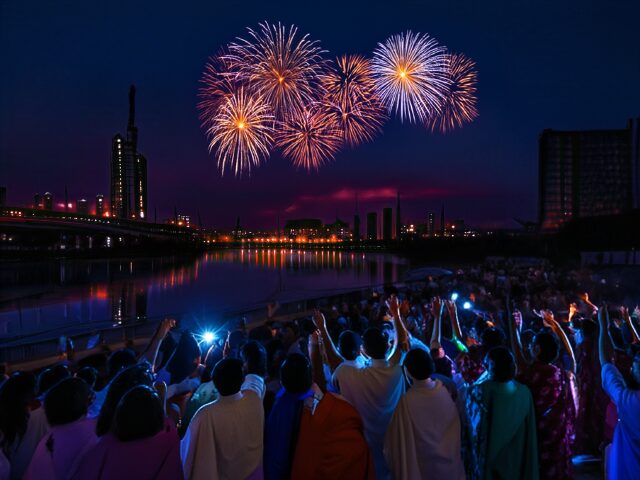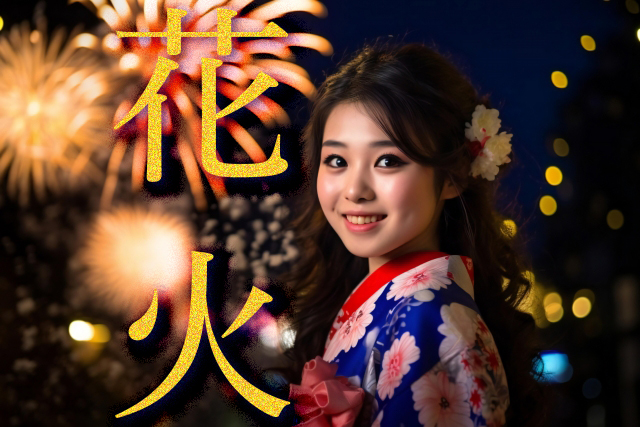Hanabi
Don to natta hanabi da, kirei da na
Soraippai ni hirogatta
Shidareyanagi ga hirogattaDotto natta nanbyaku akai hoshi
Ichido ni kawatte aoi hoshi
Mou ichido kawatte kin no hoshiLyricist:INOUE Takeshi
Composer:SHIMOFUSA Kanichi
in 1941
Fireworks
A booming sound, it’s a fireworks display, how beautiful
It spread out across the entire sky
The weeping willow spread out
With a loud noise, hundreds of red stars
Transforming all at once into blue stars
Transforming once again into golden stars

“Hanabi” The joy of fireworks sung in nursery rhymes
The children’s song “Hanabi” (Fireworks) expresses children’s longing and joy for fireworks festivals, which are a hallmark of Japanese summer. From the era when this song was created to the present day, fireworks have continued to be beloved as a special presence that colors Japanese summers.
This nursery rhyme, beginning with the lyrics “Don to natta, Hanabi da kirei dana” ( A booming sound, it’s a fireworks display, how beautiful ), expresses children’s honest surprise and emotion toward the sound and light of fireworks. The beauty of fireworks launched into the night sky has fascinated people across generations, and fireworks festivals held almost every weekend throughout summer across Japan continue to attract many people.

Shidare yanagi
Japanese summer scenes in the lyrics
The lyrics of the children’s song “Hanabi” vividly depict scenes of Japanese summer festivals. The onomatopoeia “Don Don” representing the sound of fireworks expresses the realistic atmosphere of fireworks festivals that children actually experience, inviting listeners to the festival grounds.

Utagawa_Hiroshige Meisho edo 100 kei, Ryougoku hanabi
One reason this song continues to be beloved is that fireworks festivals go beyond mere entertainment to serve as important events that deepen bonds between families and local communities. The experience of wearing yukata, visiting night stalls, and looking up at the night sky to enjoy fireworks continues to be passed down as a traditional way of spending summer in Japan.
“Sumida River Fireworks Festival.
The origin of this event is said to be the “Ryougoku no Kawabiraki” (opening of the river at Ryougoku), which was held in 1733 by TOKUGAWA Yoshimune, the 8th shogun of the Edo shogunate, to pray for the end of the plague.
Diversity of Fireworks Culture Spreading Across the Nation
Japan’s fireworks culture has various characteristics depending on the region. From large-scale competitions including the famous “Japan’s Three Great Fireworks Festivals” to small community-based local festivals, their scale and format vary widely.
Whether it’s the fireworks sung about in the children’s song “Hanabi” or modern fireworks, the underlying desire to “move and delight people” remains unchanged. While technological advances have dramatically improved the scale and beauty of fireworks, the expressions of people looking up at the large flowers blooming in the night sky are always filled with the same timeless emotion.

Inheriting Japanese Culture through Children’s Songs
The children’s song “Hanabi” plays an important cultural role in passing down Japan’s summer seasonal traditions to the next generation. Through this song, children learn about the joy of fireworks festivals and the beauty of Japanese summer.
The traditional fireworks calls “Tamaya~” and “Kagiya~” that have continued since the Edo period originated from the shop names of two major fireworks masters who competed at the Ryougoku River Opening, where spectators cheered by calling out the names of their preferred fireworks masters.Is it a characteristic of the Edo people that these calls are somewhat similar to those of Kabuki performances?
Even today, the name of Kagiya continues to be used as the name of a Tokyo pyrotechnician.
Additionally, the haiku “Omoshiroute yagate sabishiki hanabi kana” (How amusing, yet soon melancholy, these fireworks), said to be an adaptation of MATSUO Basho‘s verse, beautifully expresses the Edo summer at its peak with hints of approaching autumn, and continues to be beloved today.
Now, where will this year’s fireworks display be the most exciting?

In recent years, however, this song may be the most popular among the younger generation as it conveys well the atmosphere of fireworks and summer festivals.
Fireworks and hotel packages? For luxury stay and dinner reservations, please contact us.
![]()







コメント